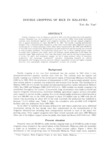Double Cropping of Rice in Malaysia
Tropical agriculture research series : proceedings of a symposium on tropical agriculture researches
| ISSN | 03889386 |
|---|---|
| NII recode ID (NCID) | AA00870529 |

Full text
tars20-_3-11.pdf1.75 MB
Double cropping of rice in Malaysia started in 1942 with the introduction of the japonica varieties. Response was very localized and it was not until the 1960s when locally developed varieties were introduced together with irrigation facilities and relevant support programs that it gained momentum to reach 284,000 ha by 1985. The double cropping phenomenon brought with it increased labor demand at a time when rural-urban labor migration was also increasing due to industrialization which offers better opportunities. By 1983 some 90,000 ha of rice land were uncultivated. Mechanization in land preparation and harvesting was resorted to with attendant problems. Transplanting culture gave way to direct seeding culture under favorable field conditions and weeds, pests and diseases caused production to fall below the expected target. High production costs and uneconomic farm size are forcing the government to review its policy and emphasize support on the 8 major granary areas to maximize productivity and encourage "commercial'' practices. Continuing research on varietal development and changing cultural practices indicate a possibility for an even higher cropping intensity once appropriate irrigation management systems are evolved.
| Date of issued | |
|---|---|
| Creator | TAN Jin Tun |
| Publisher | Japan International Research Center for Agricultural Sciences |
| Volume | 20 |
| spage | 3 |
| epage | 11 |
| Language | eng |
